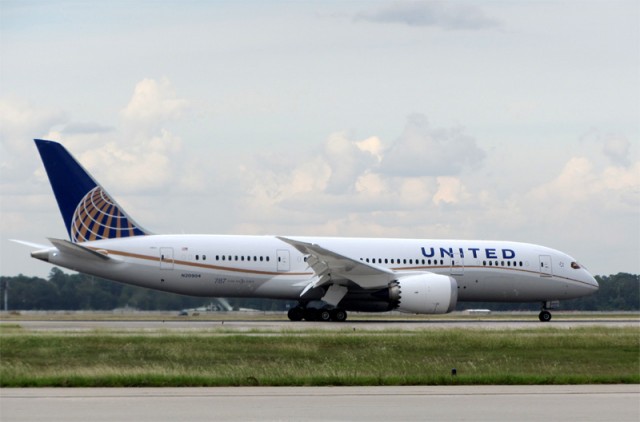
A United Boeing 787 Dreamliner. Photo by Jack Harty / Airchive.com.
An excerpt from Jack Harty’s story on Airchive.com:
More than one hundred days after the FAA grounded the 787, United Airlines flew their first post-grounding 787 flight from Houston to Chicago on May 20. More than 200 passengers, including executives from both Boeing and United, made history as they spent part of their day cruising at 41,000 feet and at a Mach speed of 0.85 on United flight 1 to mark the return of United’s Dreamliners.
On September 22, 2012, United Airlines quietly took delivery of their first Boeing 787 Dreamliner, and, six days later, they ferried it to Houston, Texas where a large crowd of employees and local journalists joined to celebrate United’s dream come true.
However, United still had to receive certification from the FAA to fly passengers. It was a long five weeks for United as they conducted safety drills, practiced aircraft servicing, and flew several proving runs to Amsterdam, Chicago, Denver, Los Angeles, Newark, San Francisco, and Tokyo. United’s second 787 was delivered on October 31 which was several days late as Boeing experienced delays. United had to scrub several 787 flights due to the delay.
Continue reading United Airlines Re-Inaugurates 787 Dreamliner Flights on Airchive.com

American’s First Boeing 777-300ER, N718AN, seen at DFW Gate D-23, the day of departure flew the inaugural flight. It signifies the birth of a new airline.
This is a continuation of Chris Sloan’s (@Airchive) report on flying on the inaugural American Airlines Boeing 777-300ER to Sao Paulo. Be sure to also check out PART 1 of the series.
The day began with a contingent of press crawling around and photographing the cabin, more on that later. The 2 Boeing 777-300ERs were at Gate D-23 (our inaugural aircraft) and another unpainted at D-24 for an employee event and to be used as backup. For an inaugural, the gate events were remarkably low-key. Missing were the obligatory ribbon cutting, cake cutting, ice sculpture, and balloon canopy.

Business in the front and party in the back! Reactions to the new livery were mixed: The updated Eagle icon, ’œbillboard’ American typography, and silver mica paint were generally well received. The flag on the tail was critiqued as being gaudy and incongruous with the elegance of the fuselage. In person, it is much more appealing and grows on you.
Downplaying the event seemed intentional because in this transition period with so much ’œup in the air’, AA had to strike the right tone in not wanting to seem extravagant or over-the-top. With this being mostly a revenue flight with very few VIPs, many in the gate weren’t even aware of the significance of the moment.

We won’t be needing ETOPS today with most of our flight over land.
There was a small snack buffet including 777 commemorative cookies, some ’œNew American’ signage, and a few words from American CEO Tom Horton and Chief Commercial Officer Virasb Vahidi with a particular shout out to the onboard products design team led by Alice Lieu. With that, the boarding began of this entirely sold out flight.

American’s First Boeing 777-300ER, N718AN, seen at DFW Gate D-23, the day of departure flew the inaugural flight. Much more than just a new aircraft joining the fleet, It signifies the re-birth of an iconic airline. Image from Chris Sloan / Airchive.com.
This is a multi-part story written by Chris Sloan (@Airchive) on the changes at American Airlines and the inaugural Boeing 777-300 flight to Sao Paulo.
On January 31, 2013 American Airlines launched their first Boeing 777-300 ER into service with attention that rivaled any airline’s launch of a new type in recent memory. On the face of it, even though American became the first operator of the 777-300 in the United States, this event would almost seem overkill if for that reason alone. After all, American began 777-200 flights back in 1999 and the first 777-300 was first delivered to an airline, Cathay Pacific back in May, 1998. The first 777-300ER entered service nearly 10 years ago with Air France. Boeing’s two stretch variants of their venerable cash cow, the 777, easily have become the type’s most popular versions with over 680 orders and deliveries between them out of the entire 777 program’s 1,380 orders and deliveries. (as of December, 2012). In an era of smaller airliners, American inaugurated the 777-300, the largest new airliner by a U.S. carrier since the last Boeing 747-400s entered service with U.S. airliners in the late 1990s.
This inaugural, flight 963, from Dallas/Ft. Worth to São Paulo, Brazil in the author’s view is one of the most significant in the airline industry in years because it is about something much bigger than just the launch of a new airliner, it’s about the re-birth of a proud American institution that happens to bear the name of our country ’“ American Airlines.
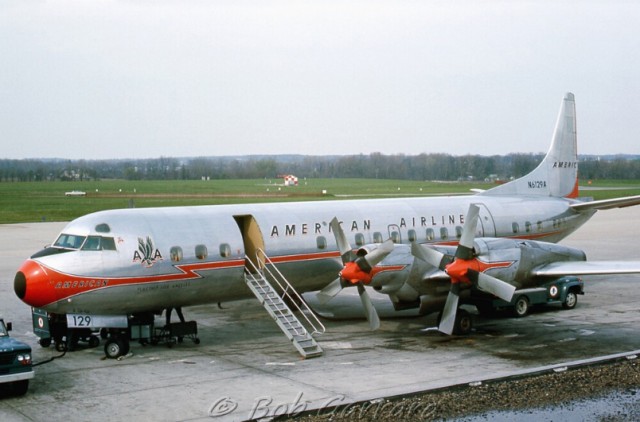
American Airlines Electra at Port Columbus International Airport (CMH) in 1967. Image by Bob Garrard.
American Airlines problems are well known. After becoming the world’s largest airline with its 2000 acquisition of TWA, the 2000s were not kind at all to the Silver Bird. TWA and American merged during an economic downturn and by most accounts, the merger was anything but an unqualified success.
American shed most of TWA’s assets, routes, staff, and many of its aircraft. On September 11th, 2 of American’s airliners, their crew, and passengers were forever lost in the atrocities of this horrible day. As if things couldn’t get any worse, the world’s airline industry hemorrhaged with the U.S. legacy carriers losing more money during this time then they had profited in their entire history. All of them declared Chapter 11, with the exception of American. Under the category of ’œno good deed goes unpunished’, this decision would come back to haunt American for years.
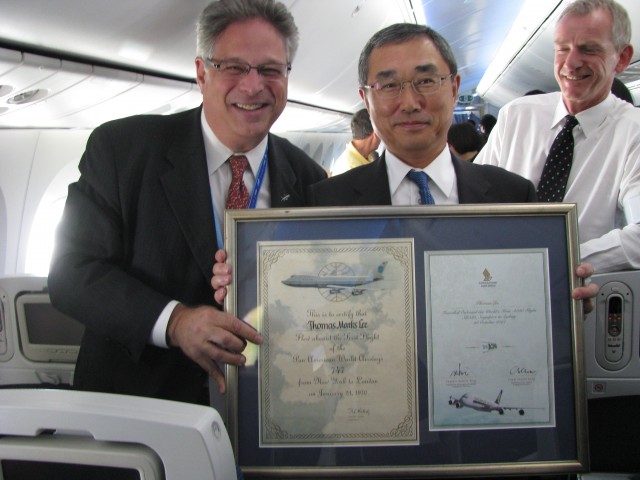
Thomas Lee with Mr. Shinichiro Ito, the CEO of All Nippon Airways, while flying the inaugural 787 flight. Photo from Thomas Lee.
AirlineReporter.com (AR): Who is Thomas Lee?
Thomas Lee (TL): I am a 60 year old businessman, originally from New York, who earned my Engineering degree from Tulane University and now reside in Orange County, California. I am married to Sally Glenn-Lee, who was President of the first class of flight attendants at Southwest Airlines and has worked her entire career in the airline industry, currently with jetBlue. I am father to Briana Lee, a 28 year old nurse and grandfather of Tatiana, an adorable 3 year old. I am Director of Marketing and Innovation in the Galleys and Equipment Segment of Zodiac Aerospace, a $4B entity with 26,000 employees globally. Every day, I work on developing the aircraft passenger cabin of the future and proudly have dozens of patents.
AR: What inaugural flights have you been on?
TL: I flew on the inaugural flight of the B747 in January 1970, a Pan Am flight from New York to London; the inaugural flight of the A380 in October 2007, a Singapore Airlines flight from Singapore to Sydney, Australia; the inaugural flight of the B787 in October 2011, an All Nippon Airways flight from Tokyo to Hong Kong and the inaugural US domestic B787 flight in November 2012, a United Airlines flight from Houston to Chicago.
AR: What is the allure of going on the inaugural flight of an aircraft?
TL: It is terribly exciting to be amongst the very first passengers to board a brand new aircraft type and experience the magic of flight in the latest aircraft technologies. One can decide for oneself whether new innovations have improved air travel. The atmosphere on these flights is electrifying. Aviation enthusiasts from around the world, airline management and the media all converge to join in the festive nature of each new aircraft launch. It is simply exhilarating.
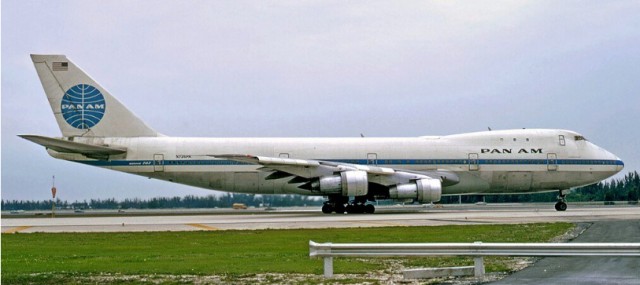
Thomas’ first inaugural flight was on this PanAm Boeing 747-100 named Victor Clipper (N736PA). Photo by Bob Garrard taken in 1973.
AR: What has been your favorite inaugural flight?
TL: My favorite would have to be the very first inaugural flight, that B747 in 1970. This was the first twin-aisle aircraft, so it was simply overwhelming boarding this behemoth when all past flight experiences had been on narrow body, single aisle planes. And it was no ordinary flight. After boarding the aircraft, every seat was filled and we taxied out for take-off. At nearly full take off speeds, there was a flame-out in engine #3 and the captain had to jam on the brakes aborting the take-off. The plane was rolled back to the gate.
Pan Am had fortunately received a second 747 just the day before from Boeing. It was parked in the hangar and was a completely green airplane with no preparation work done to get it ready for passenger service. To waste as much time as possible, Pan Am arranged for 5 extremely large Greyhound buses to pick us up at Kennedy Airport and take us to an Italian restaurant that they had completely taken over. We had a full sit-down dinner there and a long party waiting for that second aircraft to be prepped for flight.
By the time we got back to Kennedy Airport and boarded the second plane, so much time had elapsed that the first aircraft would have already landed in London. At least 30 passengers refused to board the aircraft, fearing something horrible would happen.
Another memorable part of that flight was that they didn’t have time in the rush to prepare the plane to transfer all the catering carts and equipment. So, the flight attendants laid out a buffet in the galley and we all lined up in the passenger aisles to make our way through the galley and pick up plates of food. What an amazing night.
By the way, that second plane was ’œClipper Victor’ which seven years later was involved in the worst aircraft accident in history. A KLM 747 at full take off speed, while trying to get airborne crashed into Pan Am’s Clipper Victor in Tenerife.
AR: All together, about how many miles have you flown?
TL: I would estimate that I have flown about 7.3 million miles in my life.
AR: When normally flying, what is your favorite aircraft type?
TL: I have been partial to the Boeing 777 aircraft from its inception. This was the first large commercial plane ever developed entirely on computers. The interior space feels great; the way it flies is extremely comfortable, etc. There has never been a fatal accident on a B777 which attests to its amazing design and engineering.
AR: What is your favorite airline?
TL: There are many great airlines in the world. Each creates its own brand based on that airlines ’œpersonality,’ which is driven by their culture, style of service, menus, etc. It would be impossible to pick one and say it is the best.
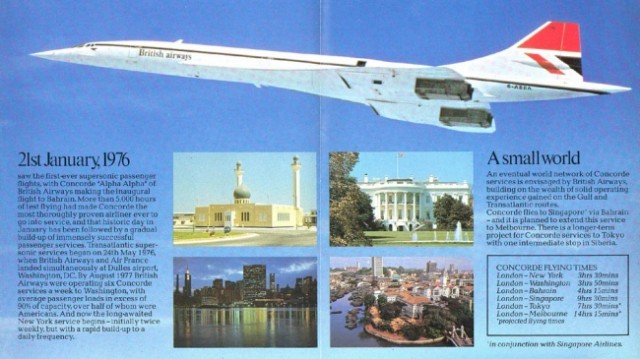
1977 – British Airways Concorde U.S. Launch Brochure. From Chris Sloan / Airchive.com.
AR: What is the inaugural flight you missed and wish you made?
TL: The Concorde as this was the first supersonic passenger aircraft. I was privileged to fly the Concorde three times and found it fantastic to look out the window at 60,000 feet and see the blackness of space above and the curvature of the earth below.
AR: Why did you not go on the Lufthansa 747-8 inaugural?
TL: I typically like to focus on ’œfirst of aircraft type’ inaugural flights. As the Lufthansa 747-8 was a ’œderivative’ aircraft, I chose not to join this journey. Of course, that doesn’t make any inaugural less exciting, but I have elected to limit my experiences to those aircraft types making their maiden voyages.
AR: What is the next inaugural flight you are planning to make?
TL: I suspect the most likely next inaugural to attempt will be the Qatar A350.
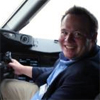 |
This story written by…
David Parker Brown, Editor & Founder. David started AirlineReporter.com in the summer of 2008, but has had a passion for aviation since he was a kid. Born and raised in the Seattle area (where he is currently based) has surely had an influence and he couldn’t imagine living anywhere else in the world.
@AirlineReporter | Flickr | YouTube |
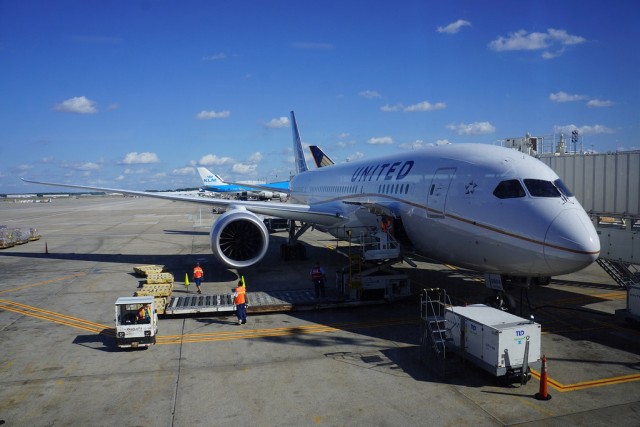
United Airline’s first Boeing 787 Dreamliner in Houston. Image by Chris Sloan / Airchive.com.
Chris Sloan, the man behind Airchive.com and is Executive Producer and Creator of Airport 24/7, was able to take the inaugural flight of United Airline’s first Boeing 787 Dreamliner. He agreed to share some of his photos and story with me and the rest of his story will be showing up on Airways Magazine in their February 2013 issues, hitting the shelves January 2nd. Here is his story, in his own words:
It is 5:00AM the morning of Sunday November 2, 2012 as I make my way over to Gate E5 at Houston’s George Bush Intercontinental Airport from a very quiet ticket counter, save for some journalists including Airways Magazine correspondent and director of social media, extraordinaire Jack Harty.
Despite the obscenely early hour, Jack and I are absolutely pumped with excitement and anticipation covering the story via live tweets, blogs, and for ’œAirways’. After foregoing a major development event, there is concern that this launch might be devoid of much of the pomp and circumstance of other launch flights, but this lack of showmanship, but this is doing little to dampen our enthusiasm for the inauguration of the first Boeing 787 to be operated by a U.S. carrier.
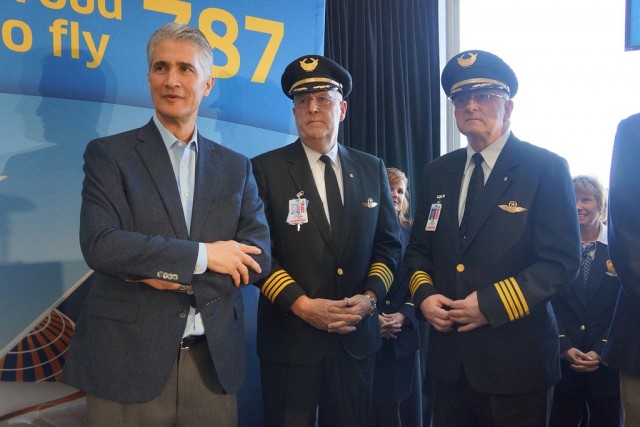
United’s CEO, Jeff Sismeck and flight crew stand on stage. Image by Chris Sloan / Airchive.com
On an optimistic note, Jeff Smisek, United’s President and CEO main theme is ’œThe 787 is worth the wait and all of our guests and members of the press are about to find out why’. Beyond all the usual groundbreaking features of the 787 normally mentioned: efficiency, pressurization, large windows, LED lighting, clean air, gust suppression technology, the humidified cabin, the ultra-quiet flight experience; Smisek gets some laughs when he says that ’œyou will all be very impressed with the lavatories’.
After the ribbon is cut, the boarding of the approximately 200 passengers begins promptly at 6:50AM. Flight 1116 from IAH-ORD is a normal operating flight with mostly paying passengers, some press, United high status customers, and of course a number of aviation enthusiasts. Many passengers are completely, but pleasantly surprised at the significance of this morning’s flight.
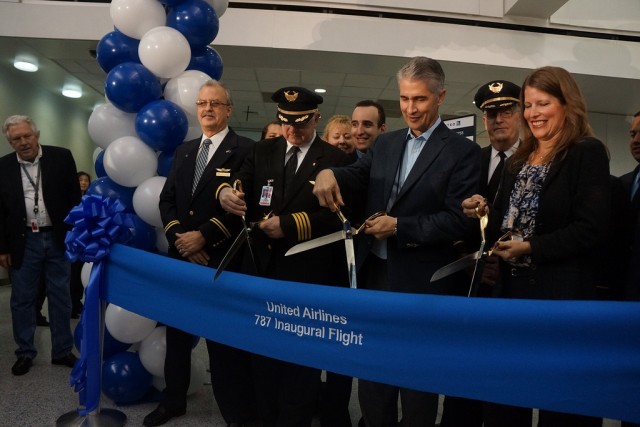
There have been many ribbons cut in the history of airline travel and this even was no different. Image by Chris Sloan / Airchive.com.
My first impressions of the cabin are positive. Though lacking the bar entry way of other airline’s 787, the entry through the gallery is still a major improvement over other aircraft, particularly with United’s blue LED boarding lighting program. I settled into my spacious seat, 6A in United BusinessFirst.
United initially chose to go big with a remarkable 8 flights scheduled on Day One involving 5 of United’s hubs: Houston Intercontinental, Newark, Chicago O’Hare, San Francisco, and Los Angles. These flights were to use 2 aircraft from the 787’s Houston base. United’s plan was to temporarily rotate the 787-8 through all of its domestic hubs that have a widebody service with domestic promotional and familiarization flights before it shifts to international operations on December 4th.
The journey to this day has been over 8 years in the making. United merger partner, Continental was the first airline in the America to placed an order for the Dreamliner shortly after the airliner was first offered to the market. Continental ordered 10 787-8s powered by the GEnx-1B.
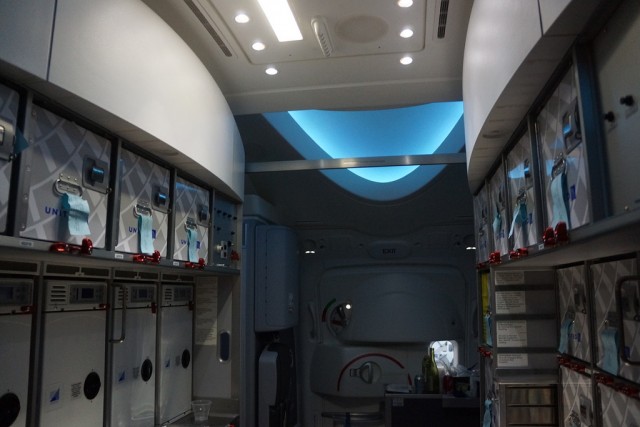
The entry way in United’s 787 is not as impressive as other 787’s, but nice none-the-less. Image by Chris Sloan / Airchive.com
The 787 would never fly under the Continental brand as United and Continental announced their merger in May 2010 and operationally on March 1, 2012. As everyone knows, the Continental Globe logo would carryover in the merger, replacing the tulip-a visual nod that this was in fact a merger of equals.
Ian Hankin, the Principal Engineer in Product Engineering points out in United PR releases that ’œgetting the 787 ready for regular operations has been more complex than for any plane to date, and the checklist of tasks runs many pages long. The different sections of the checklist correlate with various divisions throughout the company’. Hankin says ’œThis is due, in large part, to the advanced technology that makes up the plane’s structure (50 percent of which is composite materials) and the interior unique features.’
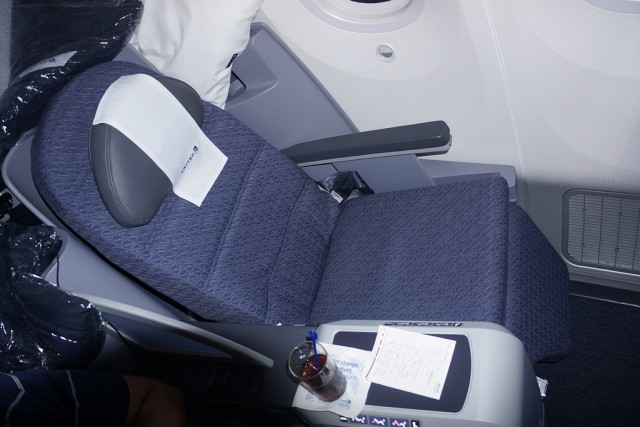
United’s BusinessFirst seats on the 787 Dreamliner. Image by Chris Sloan / Airchive.com.
United’s new BusinessFirst Cabin was initially to debut on the 787, but due to the delivery delays; it debuted on the 767 instead. It also does not feature the ’˜Dome’ dramatic entrance of some other airline’s 787s at door no. 2. Passengers enter through the galleys. Other than that, all the other Dreamliner features remain in place: the electronic dimmer buttons for the massive windows, high-arched ceiling, dynamic LED lighting, and enhanced ventilation and pressurization systems.
United’s 787 is configured with 36 seats in Business First 2-2-2 abreast with 60’ of pitch and 22’ in width. United has chosen a tighter seating layout then some 787 operators such as ANA and JAL opting for a 9 seats abreast in the economy cabins: 72 Economy Plus with 35-36’ of pitch and 18.3’ in width in a 3-3-3 abreast configuration, and 113 seats in Economy with 31’ pitch. On the return flight by the way, I sampled Premium Economy and was pleasantly surprised at how roomy it was. Panasonic’s eX2 provides the in-seat in-flight entertainment system on United’s 787 with Audio-Video on demand available at each seat. Power outlets are located at each seat in the business-class cabin and there are two for every three seats in the main cabin except for in the bulkhead rows where there are three outlets. Wi-Fi is not yet certified for the 787s. United is certainly not happy that their new flagship doesn’t have this capability, nor does any other 787 at this moment.
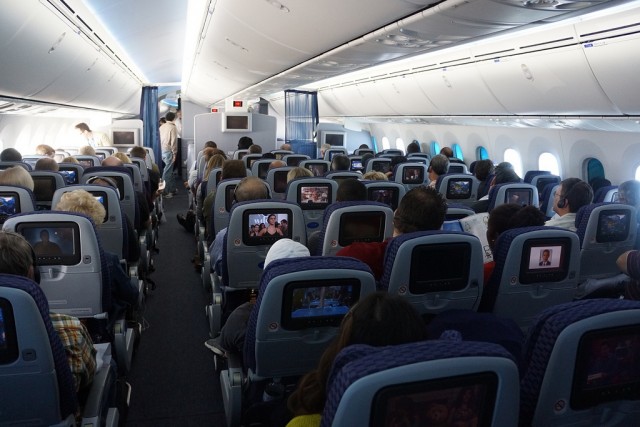
Economy is set up in a 3-3-3 format in United’s 787s. Image by Chris Sloan / Airchive.com.
According to the reservation agent, I was the first person to purchase a ticket on the first flight of Dreamliner service, the flight we are on today: United 1116. There was a lot of debate by #AvGeeks in the blogosphere and Twittersphere on whether this and the other November 4th flights would in fact be the first flights, or whether there would be special flights earlier. Even United’s press releases hinted at this possibility.
Unlike other airlines who chose splashy delivery ceremonies, United took delivery of their first 787 in a low-key manner on Sunday September 23rd. Rumors again swirled throughout the AvGeek world as to when the actual delivery would be and if there would be a large event. In the end, United chose to deliver their first 787 on Friday September 28, 011 from Boeing Field, instead of the usual Paine Field, as flight 7708 operating to Houston. There would be no fanfare upon departure. With 787 Fleet Standards Manager Captain Dave Lundy and Boeing 787 Assistant Fleet Manager Niels Olufsen at the controls, the journey between Seattle and Houston took approximately four hours departing at 9:56AM PST and landing at IAH at 3:56PM CST at an altitude of 41,000 feet. Upon arrival into United’s hub at stormy Houston George Bush Intercontinental Airport, the 787 was greeted by a water cannon salute before taxiing over to a hanger with excited employees waiting for it.
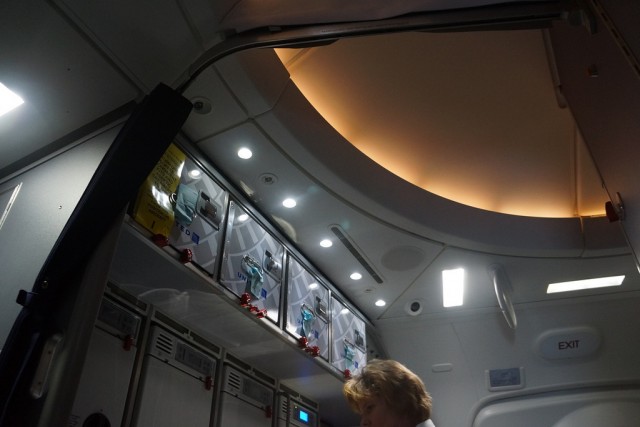
The LED lighting really sets the mood on the 787 Dreamliner. Image by Chris Sloan / Airchive.com.
This morning, Sunday November 4th there, are 4 flights operating the inaugural day: Our flight, 1116, is the first scheduled to depart early at 7:20AM with an arrival into Chicago O’Hare’s at 9:51AM. This plane is scheduled to turn-around and return back to Houston as flight 1510 after less than 2 hours on the ground in Chicago. Originally there were 8 flights scheduled, but now just 4. The remaining 2 flights of the day are: Houston-Los Angeles-Houston (IAH-LAX-IAH). United hubs at LAX, Newark, Cleveland, Denver, and Washington Dulles were scheduled to join the 787 Hub Tour throughout the month depending on the timing of the 2nd 787 being ready, with domestic revenue and familiarization flights continuing into early 2013.
We taxied out to IAH Runway 9, and at 7:27AM CST, began our very quick and very quiet 27-second take-off roll. With the aircraft only weighing 375,000 pounds (with 55,000 pounds of payload) out of a possible 502,000-pound max weight, Vr came at 140 knots in what was obviously a whisper-quiet take-off roll. A few seconds later we were airborne in a Northeastly direction to another round of applause, as is de rigueur in these occasions. We encountered a little chop in the climb to our FL41 cruising altitude, which gave a nice demonstration of the 787’s active aileron-driven gust suppression. The 787 is noticeably smoother than aircraft of its similar size such as the 767 and A330. Captain Starley came on the PA with some facts about the Dreamliner and today’s 2 hr, 9 min flight which would take us over to the east of Dallas, TX; Tulsa, OK; Springfield, MO; north of St. Louis, Joliet Illinois right into Chicago. We would fly at 504 knots and 580 mph. 19 minutes after take-off we leveled off at 41,000 feet.
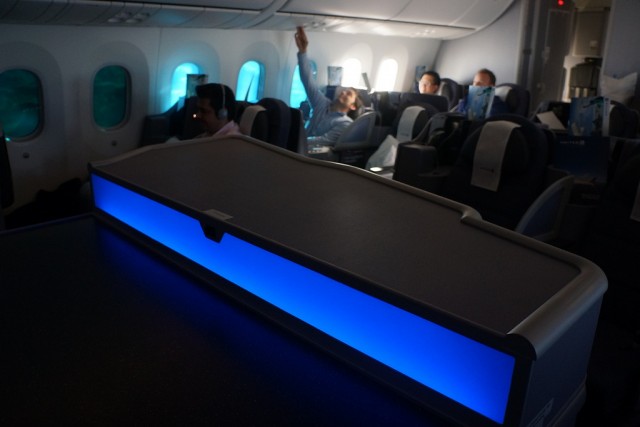
Lighting really provides a nice atmosphere in United’s 787 cabin. Image by Chris Sloan / Airchive.com.
At 7:54AM, United CEO Jeff Smisek came up from the back (yes, he was seated in Economy) and led a champagne toast, which was met with cheers. The seatbelt sign came-off briefly, albeit as the crew began their service. The LED lighting changed from the light blue cruising hue to a warm orange-ish tone, which supposedly accentuates the appearance of food. Apart from the commemorative Dreamliner souvenirs, first flight certificates, and cute custom 787 cookies, the service was fairly normal. In Business Class, we were offered tasty Egg McMuffins or cereal with fruit, yogurt, and croissants. In Economy, Buy-on-board meals were offered. The 8 Flight Attendants (11 FA’s are on international flights) who had specially bid this trip conducted a gracious, proud service while navigating around what had turned into an airborne party.
After a quick breakfast, I had an opportunity to checkout the comfortable new lie-flat seats that were very comfortable and a big improvement over the previous BusinessFirst product. If there is any complaint, it’s that the AC power and USB connections are located rather inconveniently behind the passenger at the back of the seat. The Panasonic eX2 in-flight-entertainment system is chock-a-block full of music and video on demand, games, and a high-resolution airshow moving map, but sadly United’s famous ’œChannel 9’ for listening to the pilot’s communications is missing. The IFE, while excellent, isn’t as cutting edge as some other’s but in United’s defense, it was state-of-the-art when initially ordered. My favorite, and previously unreported feature, was the smartly lit buffet / bar at the front of the forward BusinessFirst cabin. United’s seems somehow aesthetically better designed and more properly scaled than the ’œgalley bars’ on other 787s.
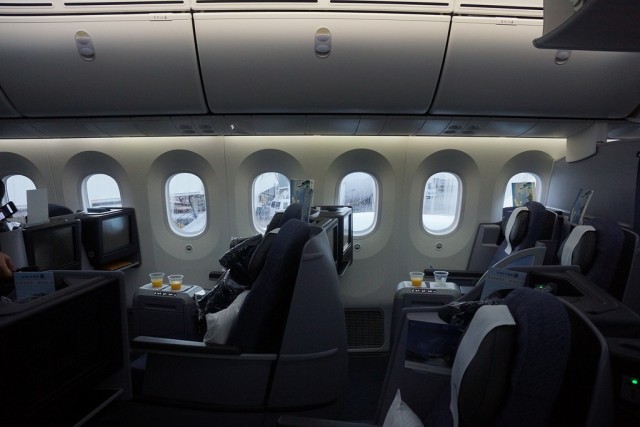
BusinessFirst seats in United’s Boeing 787 Dreamliner. Image by Chris Sloan / Airchive.com
With 40 minutes left in the flight, the air brakes came up and we began our initial descent. Captain Starley announced that we were burning an astoundingly low 9,000 pounds of fuel per hour, and that with 55 mph of tailwind were now flying at Mach .833. He termed the 787 as ’œa generational step forward’, yet ’œIt still flies like a Boeing and it’s a ’˜pilot’s airplane’’. Starley, who has flown commercially since 1973 and has flown everything from DC-8s to 777s, has the experience for his perspective to matter. Later to me, He offered that the 787s enhanced fuel efficiency is not only good for the environment and passengers, but it also equals job security for airline jobs as it allows airlines to fly more profitably at lower costs.
Captain Starley turned the 787 auto-pilot off at 4,000 feet and at 9:36AM CST executed a perfect ’œgrease job’ of a landing onto ORD’s runway 10, to cheers and clapping. We quickly exited the runway and as we taxied the first words heard over the PA, were ’œIt’s A Dream Come True’, and yes you guessed it: there was more applause. What’s an inaugural flight without the obligatory Grand Finale: ’œThe Water Cannon Salute’. These salutatory moments never get old as our 787 was given a bath from both sides of the jet. At United’s Gate C20, I deplaned right behind Jeff Smisek to a line of well-wishers and press. His remarks said it all: ’œAwesome! Just Awesome!’

United’s first two 787’s at IAH. Photo by Chris Sloan / Airchive.com.
After a short gate ceremony, United flight 1510 boarded for its on-time departure to Houston. This more subdued and conventional flight would be nearly devoid of all the ceremony of the inaugural flight. In fact, apart from being on the newest airliner of the 21st Century, it felt utterly normal. The Dream had become reality and that was the point.
See many more photos of Chris’ adventure on United’s 787 on his site Airchive.com.



















